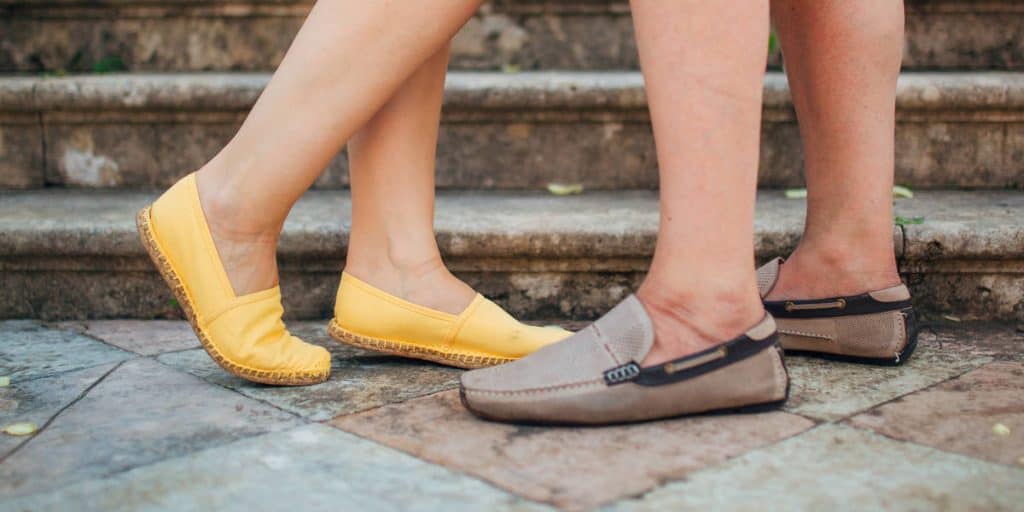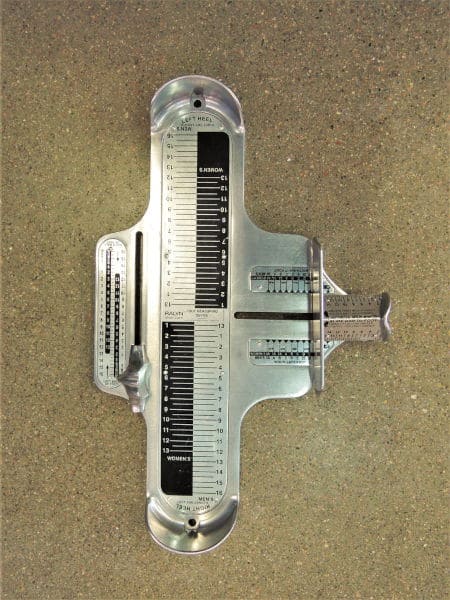What goes into buying a new pair of shoes? After accounting for taste and etiquette, the biggest factor will likely be comfort. When browsing for dress shoes – whether for the office or any elegant occasion –the differences between women’s and men’s shoe sizes may seem like an afterthought. Male and female shoes will follow completely different models, to the point that they are not easily interchangeable.
However, if you’re looking for athletic shoes or safety gear, the differences aren’t as obvious. Women do have, on average, smaller feet than men. But wouldn’t it still be more convenient if all shoes used the same sizing system? Or are there other differences in foot shape, sturdiness, or function hiding behind the different sizing systems?

What is the main difference between men’s and women’s shoe sizes?
The main difference lies in the sizing systems used. Men’s and women’s shoes follow completely different sizing models that are not interchangeable. Looking at foot length alone, there is typically a 1.5 size difference between men’s and women’s shoes for the same foot size.
And yet, this is only half of the story. Your shoe size may not be the same across different shoe companies. “Half-sizes” are easier to find in women’s sizes than in men’s. Even shoe width (the letter next to the size number) varies across shoe brands and shoe “gender.”
Specialized shoe brands can offer up to nine width sizes. Most offer five: A, B, C, D, and E, with A being the narrowest. But a “medium” width for women’s shoes is a B, while for men’s, it’s a D. Proper shoe fit goes beyond size and requires an understanding of these nuances.
The differing size systems almost feel like they were designed to create confusion!
It almost feels like they’re making it confusing on purpose!
Are men’s and women’s feet really that different?
Men’s and women’s feet exhibit key differences beyond basic size and width measurements. Research in recent decades has unveiled distinctions in bone structure, foot shape, and biomechanical function between the sexes.
Even after accounting for height and weight, women’s feet will generally follow different proportions than men’s. Let’s imagine a “typical” 5’9’’ adult for reference:
- The average 5’9″ adult man’s feet are 10.75″ long, equivalent to a men’s shoe size 10 or 11.
- The average 5’9″ adult woman’s feet are 10.18″ long yet equate to a woman’s shoe size 10.
Moreover, men’s and women’s feet differ in shape with women tending to have narrower heels but wider forefeet. 76% of women have wider forefeet relative to the heel compared to 48% of men according to a 2021 study.
Finally, the last factor to account for is the “Q-angle.” Unlike length or width, the Q-angle isn’t immediately visible on the shoe, as it is not located on the feet at all. Instead, this term refers to the angle formed by the quadriceps muscle, where it joins with the patellar tendon (in the knee).
Women have wider hips, which means they are also likely to have a wider Q-angle. In turn, this also slightly alters the angle at which the foot strikes the ground. As a result, many performance-oriented women’s shoes also add extra support around the forefoot to compensate. This is meant to prevent stress fractures or other overuse injuries.
Or call us at: (855) 829-7821
Material and weight matters
Larger, heavier bodies need more resilient shoes, so shoe manufacturers also need to tweak the materials they use when designing shoes for men vs women.
This is particularly noticeable with running shoes, where cushioning and shock absorption features take the front stage. To absorb the shock from a heavier body, men’s shoes will often require denser cushioning, especially around the midsole.
Meanwhile, denser cushioning across a wider surface will create a heavier shoe. The difference appears minimal on the label: a pair of New Balance Fresh Foam X shoes for men weighs 262 grams (9.2 oz), while its women’s counterpart weighs 206 grams (7.3 oz). However, this may be enough to slow you down in a competitive event.
Should you avoid shoes from the “opposite gender”?
Not necessarily. All the calculations and adjustments we’ve described were designed around averages, but people’s feet are as individual as they are.
Some women are heavier or more densely muscled than average and could benefit from the extra cushioning of a “male” shoe. Meanwhile, the larger toe box or extra support of a “female” shoe can also help a man with pronation issues. As half-sizes are more common in women’s lines, opting for women’s shoes can help men prevent the risks of oversized shoes.
Many athletic brands continue to price their women’s shoes differently from their male equivalents, while others just have a wider variety of shoe styles in the male section. Therefore, women with larger feet may find it easier to just shop in the men’s section.
Ultimately, you should get the shoes that make your feet happiest – even if finding them requires some trial and error.

Shoe size conversion made simple
Getting the right shoe fit is not a simple task. If you’re trying out a new model or brand for the first time, your best bet is to go to the store in person.
Once there, ask the sales attendant if they have a Brannock device. This is a special metal ruler that will give you a precise measurement, in centimeters, of your feet length, width, and arch. Once you have a set of objective numbers, check the size conversion charts for each brand, and find the one that falls closest to your feet.
But what if you’re simply replacing an old favorite, and they’re out of stock? In this case, start with the table below:
| Men’s Size | N/A | 5 | 5.5 | 6 | 6.5 | 7 | 7.5 | 8 | 8.5 | 9 | 9.5 | 10 |
| Women’s Size | 6 | 6.5 | 7 | 7.5 | 8 | 8.5 | 9 | 9.5 | 10 | 10.5 | 11 | 11.5 |
Next, make sure you stick to the same width letter! If you usually wear a “medium” width, remember this usually stands for a B in women’s shoes, or a D in male shoes.
Either way, you should always try out at least two different sizes and widths.
If you’re shopping for safety or industrial shoes (like steel-toed boots), you may not even find men and women’s sizes at all; these are supposed to be “unisex shoes.” Assume they follow the men’s standard.
Looking to protect your feet health for the long term? Come to UFAI
For many foot and ankle issues, the first line of prevention often lies in the shoe. At the Foot and Ankle Institute, our team of expert podiatrists, surgeons, and physical therapists can all help you diagnose, prevent, and treat anything from frequent pain to chronic foot and ankle injuries.
For a consultation please call (877) 736-6001 or make an appointment online now.
University Foot and Ankle Institute is conveniently located throughout Southern California and the Los Angeles area as our foot doctors are available at locations in or near Santa Monica, Beverly Hills, West Los Angeles, Manhattan Beach, Northridge, Downtown Los Angeles, Westlake Village, Granada Hills, and Valencia.
- The Link Between Foot Health and Posture - April 14, 2024
- Why Are My Feet Different Sizes? It’s More Common Than You Think - March 27, 2024
- Custom Orthotics vs. Over-the-Counter Inserts: Which Are Best for Your Feet? - February 7, 2024